Times they are a changin’, as Bob Dylan would say. Comic books are no longer the sole purview of teenage boys (were they ever?!). Let me introduce you to me… Hi, I’m an adult woman and I love comics. And guess what? I’m not alone. Comic book creators have figured something out that Hollywood is choosing to ignore – that women spend money too. And, unsurprisingly, women enjoy seeing themselves portrayed in the media they like to consume. That is not to say (obviously!) that women don’t enjoy seeing men portrayed as well, we are just ordinary humans who, naturally, enjoy a little variety.
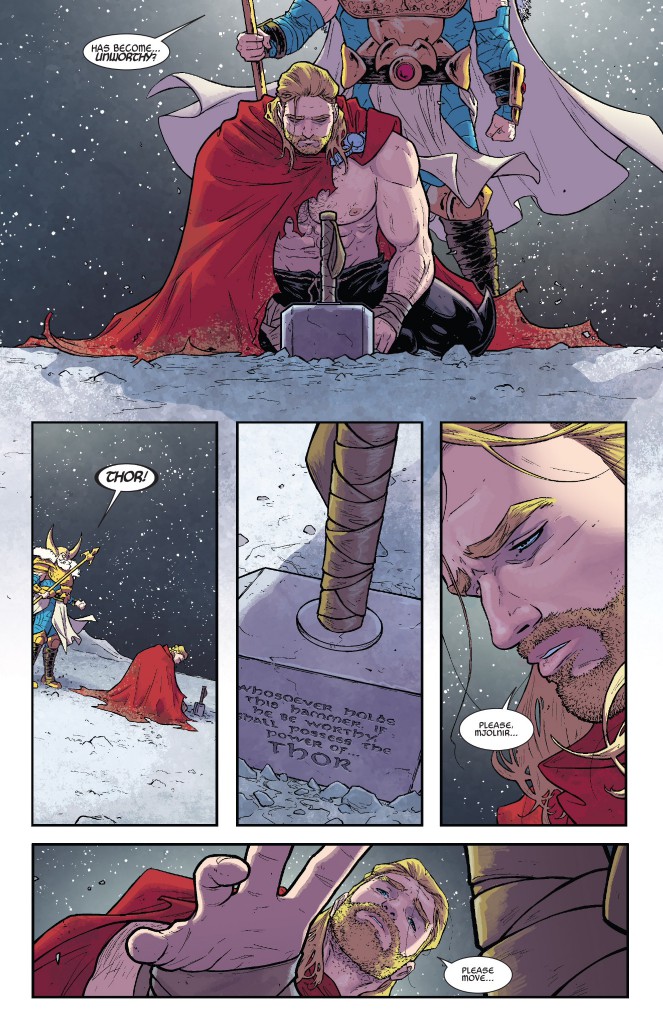 While we have to wait until 2017 for DC’s Wonder Woman in a female-driven superhero film (followed by Marvel’s Captain Marvel film in 2018), comics themselves haven given us female superheroes for some time, though not always in the most forward-thinking fashion. The character of Wonder Woman first appeared in 1941, with Marvel’s Captain Marvel having gone through many incarnations, the first of which was not even female. Marvel has since made up for this by giving us the first mainstream superhero comic with a woman of colour as the main character in Ms. Marvel with Kamala Khan.
While we have to wait until 2017 for DC’s Wonder Woman in a female-driven superhero film (followed by Marvel’s Captain Marvel film in 2018), comics themselves haven given us female superheroes for some time, though not always in the most forward-thinking fashion. The character of Wonder Woman first appeared in 1941, with Marvel’s Captain Marvel having gone through many incarnations, the first of which was not even female. Marvel has since made up for this by giving us the first mainstream superhero comic with a woman of colour as the main character in Ms. Marvel with Kamala Khan.
Thor? Are you kidding me? I’m supposed to call you Thor? Damn feminists are ruining everything!
Though comics have given us a number of strong female characters, few have taken the limelight as the center of an ongoing series – and if they did, they often found themselves kitted out for a day at the beach rather than saving the world. Things have slowly been changing for the better, with the odd depiction of a woman with a real-ish looking body shape, but nothing heralded a change of attitude more than Marvel’s gender inversion of one of its leading properties – Thor.
Why it was time for a change
With Thor and its sequel being successes at the box office, it seemed an odd time for Marvel to up and change how the character was represented in the comics. Before the films, I must admit that I knew nothing of the Marvel version of Thor and the Asgardians (only a little knowledge of the actual Norse myth) and I imagine many non-comic book fans were the same. So why, when they had successfully brought Thor into the mainstream, did they decide to change the character so fundamentally?
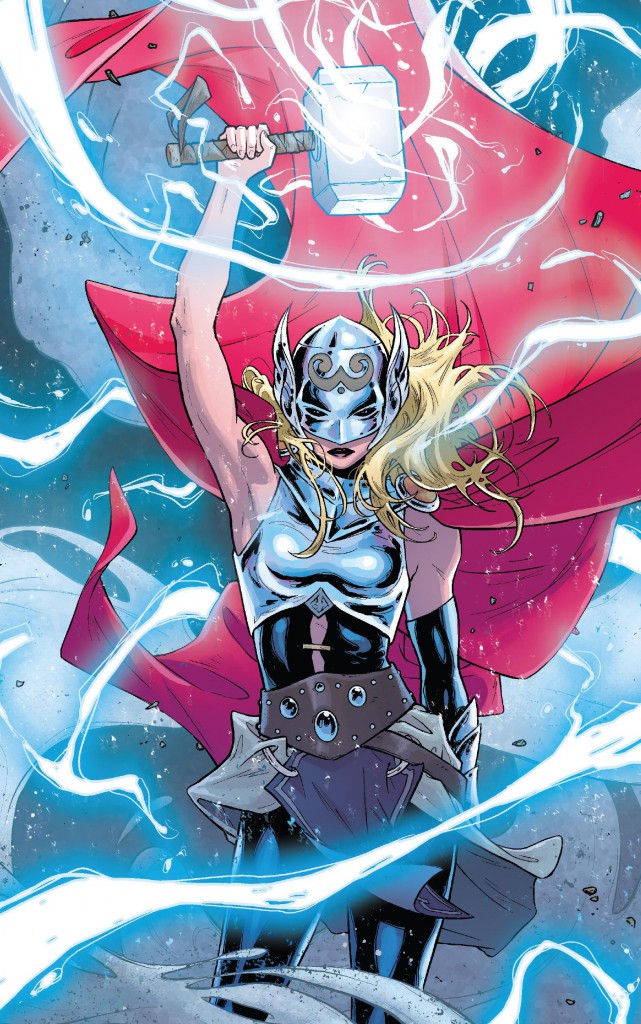 Firstly, changing up the casting-call of Thor is easier – and more logical within the rules of the universe – than many of Marvel’s other assets. Unlike most superheroes (who have also often changed characters, usually in nonsensical ways), it is the hammer, Mjolnir, that gives Thor his power rather than anything innate to Thor himself (except a ‘worthiness’ – note that this refers to the lore of the hammer as it stands now). So passing on the identity of Thor to another is far more logical with Thor than it is with someone like Captain America (superpowers-wise at least), Spider Man, or the Hulk, and so on.
Firstly, changing up the casting-call of Thor is easier – and more logical within the rules of the universe – than many of Marvel’s other assets. Unlike most superheroes (who have also often changed characters, usually in nonsensical ways), it is the hammer, Mjolnir, that gives Thor his power rather than anything innate to Thor himself (except a ‘worthiness’ – note that this refers to the lore of the hammer as it stands now). So passing on the identity of Thor to another is far more logical with Thor than it is with someone like Captain America (superpowers-wise at least), Spider Man, or the Hulk, and so on.
Secondly, Thor is as old as they come: an immortal god. The idea of that kind of stagnation can really limit the potential for stories – how do you create tension when he can never die? Well, his hammer responds to those who are ‘worthy’ – living forever doesn’t mean you will always be worthy. People change, as do societies. Something that comic points out with Odin’s rule. Having been absent for some time, leaving Freyja in charge, many of the Asgardians grew to prefer the all-mother’s rule over Odin’s. Is it really time for Freyja to remember her place or time for her to carve out a new one?
It is time you remembered your place in that world, Freyja.
The blurring of masculinity and femininity
What is truly wonderful about this series is that Jason Aaron, the writer, understands that this isn’t a debate about masculinity vs. femininity. Female Thor adopts the same grandiose manner of speaking, something that is suggested to be the influence of the hammer, as well as the physical and mystical capabilities. The original male Thor is not less of a man having lost his hammer and his personality remains unchanged (quick to temper, loves the drink and the ladies). And the shift in power – or perhaps the equality of it – is also represented when Titania and Crusher show up – Titania has to come to the rescue of her big beefy husband.
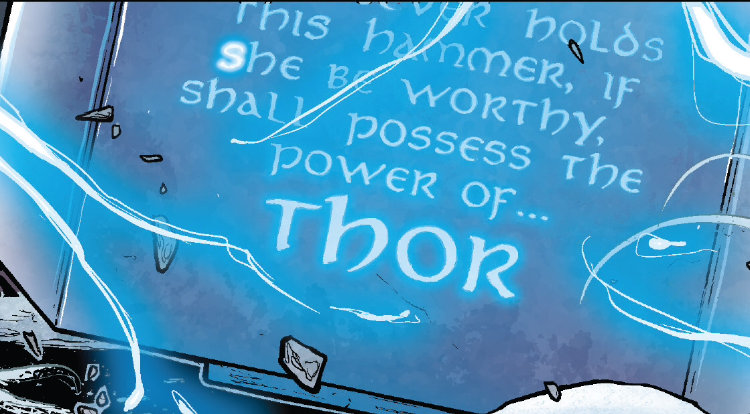 When the goddess of thunder encounters supervillain Titania, instead of having it out in an epic battle, Titania throws aside her weapon. Even a villain has to give props to such a badass woman. But just when you think that new Thor will cast her weapon aside as well, as the anti-feminists begin to jeer at the weak willed woman, Thor shows once again how mighty she really is. She takes out Titania in one swift hit, without hesitation. Even though Titania has conceded defeat, she’s still a baddie, she’s still a threat. And Thor will take no chances.
When the goddess of thunder encounters supervillain Titania, instead of having it out in an epic battle, Titania throws aside her weapon. Even a villain has to give props to such a badass woman. But just when you think that new Thor will cast her weapon aside as well, as the anti-feminists begin to jeer at the weak willed woman, Thor shows once again how mighty she really is. She takes out Titania in one swift hit, without hesitation. Even though Titania has conceded defeat, she’s still a baddie, she’s still a threat. And Thor will take no chances.
The message always stays on point: this isn’t about the size of your muscles or the genitalia you have in your pants, it is all about who you are inside and the purity of your intentions. Thor Odinson, it is suggested, became to insular, thinking of himself before others. But goddess Thor is driven to fulfil a singular purpose: protect Midgard. Nothing else gets past her focus on that one mission. Thus she truly is simply ‘Thor’, taking his name along with his hammer.
She ain’t called She-Thor or Lady Thunderstrike or nothing like that?
Thor, Odinson, graciously steps aside
Once Thor Odinson eventually realizes that Mjolnir was not in fact stolen, rather than lost to him for his own unworthiness, he manages to step aside gracefully. This surprised me at first, he with the foul temper and all, but it actually does feel rather fitting. For all his faults, Thor does manage to find a down-to-earth center at times. And he has never had an issue with women, as such – he loves his mother and treats her with a great deal of respect. He might sleep around a little, but he has no trouble with strong, intelligent women who have lives of their own. If ever there was a male superhero who’s a proud feminist, it’s Thor.
That’s for saying “feminist” like it’s a four letter word, creep.
Marvel took a risk with changing up one of their most beloved characters and series in such a way, but that risk has paid off. What they have discovered is that great stories and great characters don’t exclude on gender and that fans will still buy comics where the woman is in charge. Now if only they could pull the same off on-screen, we’d really be getting somewhere.
 Pop Verse Pop Culture Universe
Pop Verse Pop Culture Universe
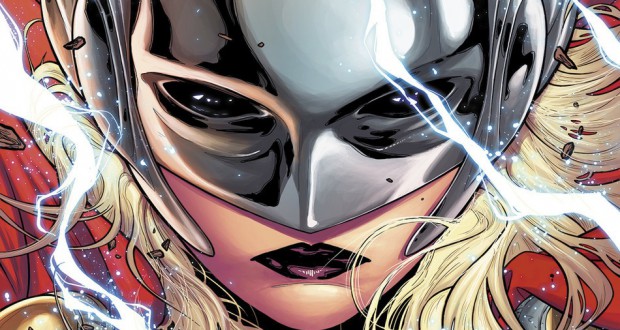
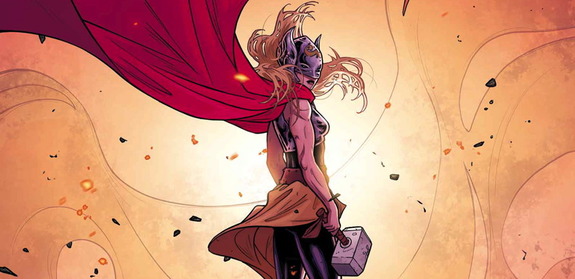

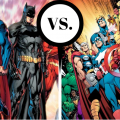




One comment
Pingback: Should we care about gender flipped reimaginings? | Pop Verse